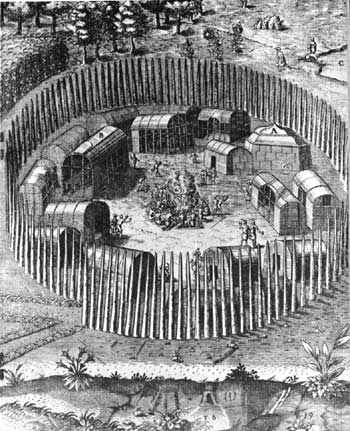|
FORT RALEIGH National Historic Site |
 |

The Indian Village of Pomeiooc, engraved by De Bry from a drawing
by John White.
The Lost Colony of 1587
In the year 1587, Sir Walter Raleigh organized another colonial expedition consisting of 150 persons. Its truer colonizing character was evidenced by the significant facts that, unlike the expedition of 1585, this one included women and children, and the men were called "planters." Its government was also less military, since the direction of the enterprise in Virginia was to be in the hands of a syndicate of sub-patentees—a governor and 12 assistants whom Raleigh incorporated as the "Governor and Assistants of the Citie of Ralegh in Virginia."
The new arrangement indicated that colonization was becoming less of a one-man venture and more of a corporate or business enterprise, anticipating in a certain degree the later English companies that were to found successful colonies in Virginia and New England. Exactly what inducements Raleigh offered to the planters are not known. His terms were probably liberal, however, because Hariot, writing in February 1587, paid tribute to Raleigh's generosity, saying that the least that he had granted had been 500 acres of land to each man willing to go to America. Those contributing money or supplies, as well as their person, probably stood to receive more. From the list of names that has come down to us, it would appear that at least 10 of the planters took their wives with them. Ambrose Viccars and Arnold Archard brought not only their wives but one child each, Ambrose Viccars and Thomas Archard. Altogether there were at least 17 women and 9 children in the group that arrived safely in Virginia.
In still another respect, this second colonial expedition seemed to anticipate the later Jamestown settlement. Raleigh had directed, in writing, that the fort and colony be established in the Chesapeake Bay area where a better port could be had and where conditions for settlement were considered to be more favorable.
The fleet, consisting of three ships, sailed from Plymouth for Virginia on May 8. Continuity with the previous expeditions was afforded in the persons of the Governor, John White, who was to make in all five trips to Virginia, Simon Ferdinando, Captain Stafford, Darby Glande, the Irishman, and perhaps others. The route, as in 1585, lay via "Moskito Bay" in Puerto Rico. Here Darby Glande was left behind, or escaped, and lived to testify regarding the first Roanoke Island colony before the Spanish authorities at St. Augustine some years later. The expedition sailed along the coast of Haiti, even passing by "Isabella" where Grenville had traded with the Spaniards for cattle and other necessities in 1585, but this time there was no trading, possibly because of the precarious relations between England and Spain, now on the eve of open war. Whatever the reason for this failure to take in supplies in Haiti, it constituted a certain handicap for the colony of 1587.

|

| History | Links to the Past | National Park Service | Search | Contact |
|
Last Modified: Mon, Dec 2 2002 10:00:00 am PDT |

